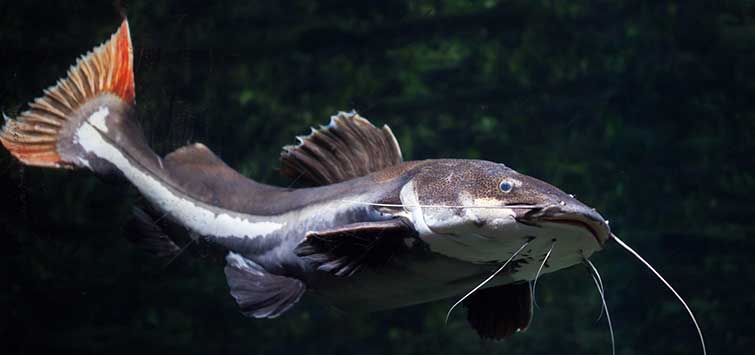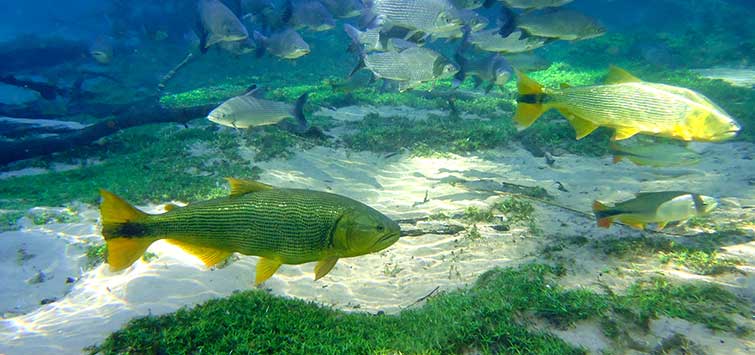Monsters Among Us
Author: Arthur Masloski
Although they may appear small at the store, some large-growing species require much more room than you might expect. An expert hobbyist reviews some of the biggest offenders and outlines their specific (and sometimes impossible) care requirements.
Real Monsters!
The aisles of fish at any pet store are enough to both excite and alarm any budding fishkeeper. Finding the right fish for a setup can be a daunting task, especially if there is not a lot of information on the fish you see at hand. The key to overcoming this issue is research.
I always suggest doing research on any fish that catches your eye—for your own sake and for the sake of the fish. You might think that any fish being sold at a fish store should be appropriate to take home. Why would a pet store sell an animal you couldn’t successfully keep? Well, all the fish I’m about to mention can be kept successfully, but it is doubtful that you have an aquarium appropriate to house them. If you do, you probably didn’t get it from the same store, as most fish shops don’t seem to carry tanks larger than 55 to 75 gallons without special-ordering them.
Before I get into the meat and potatoes of this article, I would like to make a quick note on the persistent myth that fish grow only as large as their tanks allow. This simply is not true. In fact, fish growth operates in quite the opposite sort of way. Fishes are “indiscriminant growers,” which means they don’t really ever stop growing.
Common Monsters for the Home Aquarium
Provided their needs are properly met, they should continue growing throughout their lives, even if that growth greatly slows down once they meet their typical maximum size. The only thing that will inhibit the growth of a fish is improper husbandry. High stress, poor nutrition, inadequate water parameters, and lack of cleanliness all contribute to fish stunting, disease, and an untimely death. That said, let’s examine a few of the more commonly encountered monsters among us.
Bala Shark
The bala shark (Balantiocheilos melanopterus) is a large member of the cyprinid family, which includes carps, minnows, and barbs, and is found in nearly every pet shop that carries fish. Customers are attracted to it mostly for the shark name, but it is completely unrelated to true sharks.
Often sold as a community fish, this species, which hails from Southeast Asia, can reach lengths of 10 to 14 inches. This size is not unmanageable, but the activity level and social life of this species are factors that need to be considered. These fish are called sharks for a reason, that classic torpedo-shaped body. That body type is found in active and fast-moving species. While some species that reach a similar size can be housed in a 55- to 75-gallon tank, the bala shark would find such conditions very cramped and likely displace a lot of water in its quick bursts across the tank.
The bala shark is also a social fish that likes to live in groups. As such, in order for the species to thrive, it must be kept with more of its own kind. While one specimen could theoretically be kept in something the size of a 75-gallon setup, it would be stressed just from being alone, so in order to keep more than one, you’ll need something considerably larger. Considering that the majority of bala sharks in the aquarium trade end up in small community tanks, it is very important to take into account what these fish will ultimately become.
Tinfoil Barb
Like the bala shark, the tinfoil barb (Barbonymus schwanenfeldii) is another large, fast-moving, and schooling species of cyprinid from Southeast Asia that can reach lengths between 10 and 14 inches. Any fishkeepers with aspirations for anything less than a 75-gallon aquarium would be hard-pressed to properly care for these fish.
Pet shops offer many barbs that would make manageable community fish. Species like tiger, clown, cherry, and rosy barbs all stay under 4 to 6 inches, and it would be easy for new hobbyists to mistakenly think the same for the tinfoil barb. This is a great “poster child” species for the importance of proper research. Don’t assume that just because a fish’s name has “barb” in it and it’s kept with community fish in a pet store that it is a viable choice for your typical setup. Do so, and you could end up with only a couple well-fed, giant fishes in need of new homes.
Pacu
There are two species of fish known as pacu in the aquarium trade, and both should be avoided: the large black pacu (Colossoma macropomum) and the more common red-belly pacu (Piaractus brachypomus). The former can reach 3 feet and 66 pounds while the latter can reach about 2 feet and up to 55 pounds. These fish are truly tankbusters if there was ever any fish deserving of the name.
Their popularity, no doubt, stems from the fact that they are related to and resemble piranha, but truth be told, you might be better off with the piranha. Like piranha, these fish come from South America where they are among the largest members of the characin, or tetra, family. The red-belly used to be quite common in the aquarium trade and was found in most fish shops, including the big-box stores, but lately, it seems to have become less common.
Hopefully a lot of fishkeepers were made aware of just how unmanageable these giants are and the stores responded in kind. Whatever the case may be, if you happen to come across these, I suggest avoiding them at all costs. There are few hobbyists who can properly house adult pacu, fish that, like the aforementioned bala shark and tinfoil barb, prefer to live in groups. For something similar, I suggest the popular silver dollars of the Metynnis genus. These pacu alternatives reach about 6 inches in length.
Knifefish
Among the most captivating fish at any place that sells them are two species that share the name knifefish: the clown and black ghost knife. These fishes are completely unrelated but, due to convergent evolution, share a very similar body plan and function. The clown knifefish (Chitala chitala) is a member of the very primitive Osteoglossiformes, or “bony tongue,” order of fishes. Clown knives are native to Southeast Asia, Indonesia, and India and can reach up to 3 feet in length. Despite their size, a lot of fish shops carry these bizarre fish.
A related species from Africa, the brown knife (Xenomystus nigri) is not quite as flashy, but at only 10 to 12 inches, it is a much more manageable size.
The black ghost knifefish (Apteronotus albifrons) belongs to the Gymnotiformes order of fishes along with the well known electric eel (Electrophorus electricus) and comes from South America where it navigates its murky waters using electric impulses much like the electric eel. This stunning species stays smaller than the clown knife at 15 to 20 inches, but nothing smaller than a 75-gallon tank can be recommended and one could very well outgrow even a tank that large.
Iridescent Shark
One of the largest fishes you’re likely to encounter for sale—and probably the least suited to aquarium life—is the iridescent shark (Pangasianodon hypophthalmus). Mostly popular due to its name and physical similarity to true sharks, this species is actually a catfish from Southeast Asia. The largest specimens of this species can reach a length of 4 feet and a weight of 96 pounds. That is the length of a 55- to 75-gallon tank and the weight of a small human packed into a torpedo-shaped, well-muscled fish.
Like the previously mentioned bala shark and tinfoil barb, this is also a social species that prefers to live in groups. Even when small, these fish will displace a lot of water in their bursts across the tank, and they have been known to physically knock themselves out by slamming into the glass.
This species shouldn’t be sold in any pet shop, but, unfortunately, nearly every pet shop carries them. Any attempt to keep one will only bring stress and despair, and I doubt there are more than a few individuals that actually achieve their potential lifespan. I realize this all sounds a bit dramatic, but it is true regardless. The iridescent shark is raised in Asia as a food fish but has no place along the aisles of any pet shop. Alas, I have yet to see a store without them.
Research for a Healthy Tank
I hope you heed these warnings and share this information with others interested in this hobby. There are a lot of great fish to choose from in most pet shops—a lot of different community fish, some truly bizarre ones, and even some manageable large species. This article covers only some of the more common species you’ll encounter, but there are many others. You can avoid problem fish by simply researching before you buy and by keeping in mind whenever you step into a fish shop that there truly are monsters among us.
See the full article on TFH Digital http://www.tfhdigital.com/tfh/february_2014#pg73

.png?h=595&iar=0&w=2781&hash=5FD5E69473BCC22199FBFA2FB71B6033)



